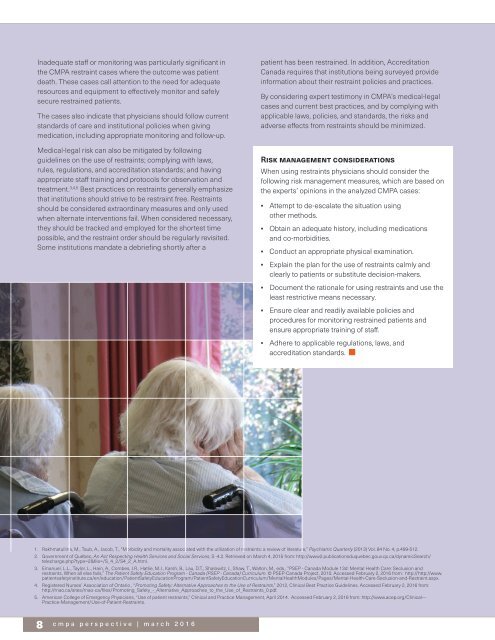CMPA Perspective March 2016
Create successful ePaper yourself
Turn your PDF publications into a flip-book with our unique Google optimized e-Paper software.
Inadequate staff or monitoring was particularly significant in<br />
the <strong>CMPA</strong> restraint cases where the outcome was patient<br />
death. These cases call attention to the need for adequate<br />
resources and equipment to effectively monitor and safely<br />
secure restrained patients.<br />
The cases also indicate that physicians should follow current<br />
standards of care and institutional policies when giving<br />
medication, including appropriate monitoring and follow-up.<br />
Medical-legal risk can also be mitigated by following<br />
guidelines on the use of restraints; complying with laws,<br />
rules, regulations, and accreditation standards; and having<br />
appropriate staff training and protocols for observation and<br />
treatment. 3,4,5 Best practices on restraints generally emphasize<br />
that institutions should strive to be restraint free. Restraints<br />
should be considered extraordinary measures and only used<br />
when alternate interventions fail. When considered necessary,<br />
they should be tracked and employed for the shortest time<br />
possible, and the restraint order should be regularly revisited.<br />
Some institutions mandate a debriefing shortly after a<br />
patient has been restrained. In addition, Accreditation<br />
Canada requires that institutions being surveyed provide<br />
information about their restraint policies and practices.<br />
By considering expert testimony in <strong>CMPA</strong>’s medical-legal<br />
cases and current best practices, and by complying with<br />
applicable laws, policies, and standards, the risks and<br />
adverse effects from restraints should be minimized.<br />
Risk management considerations<br />
When using restraints physicians should consider the<br />
following risk management measures, which are based on<br />
the experts’ opinions in the analyzed <strong>CMPA</strong> cases:<br />
▪▪<br />
▪▪<br />
▪▪<br />
▪▪<br />
▪▪<br />
▪▪<br />
▪▪<br />
Attempt to de-escalate the situation using<br />
other methods.<br />
Obtain an adequate history, including medications<br />
and co-morbidities.<br />
Conduct an appropriate physical examination.<br />
Explain the plan for the use of restraints calmly and<br />
clearly to patients or substitute decision-makers.<br />
Document the rationale for using restraints and use the<br />
least restrictive means necessary.<br />
Ensure clear and readily available policies and<br />
procedures for monitoring restrained patients and<br />
ensure appropriate training of staff.<br />
Adhere to applicable regulations, laws, and<br />
accreditation standards.<br />
1. Rakhmatullina, M., Taub, A., Jacob, T., “Morbidity and mortality associated with the utilization of restraints: a review of literature,” Psychiatric Quarterly (2013) Vol. 84 No. 4, p.499-512.<br />
2. Government of Québec, An Act Respecting Health Services and Social Services, S -4.2. Retrieved on <strong>March</strong> 4, 2015 from: http://www2.publicationsduquebec.gouv.qc.ca/dynamicSearch/<br />
telecharge.php?type=2&file=/S_4_2/S4_2_A.html.<br />
3. Emanuel, L.L., Taylor, L., Hain, A., Combes, J.R., Hatlie, M.J., Karsh, B., Lau, D.T., Shalowitz, J., Shaw, T., Walton, M., eds., “PSEP - Canada Module 13d: Mental Health Care: Seclusion and<br />
restraints, When all else fails,” The Patient Safety Education Program - Canada (PSEP - Canada) Curriculum. © PSEP-Canada Project, 2010. Accessed February 2, <strong>2016</strong> from: http://http://www.<br />
patientsafetyinstitute.ca/en/education/PatientSafetyEducationProgram/PatientSafetyEducationCurriculum/MentalHealthModules/Pages/Mental-Health-Care-Seclusion-and-Restraint.aspx.<br />
4. Registered Nurses’ Association of Ontario , “Promoting Safety: Alternative Approaches to the Use of Restraints,” 2012, Clinical Best Practice Guidelines. Accessed February 2, <strong>2016</strong> from:<br />
http://rnao.ca/sites/rnao-ca/files/Promoting_Safety_-_Alternative_Approaches_to_the_Use_of_Restraints_0.pdf.<br />
5. American College of Emergency Physicians, “Use of patient restraints,” Clinical and Practice Management, April 2014. Accessed February 2, <strong>2016</strong> from: http://www.acep.org/Clinical---<br />
Practice-Management/Use-of-Patient-Restraints.<br />
8 cmpa perspective | march <strong>2016</strong>


